
A fitting image that encompasses Misty’s efforts over the past year. Her models are a line-up of her daughters, sister, family and friends. “They bring life to a collection that was designed to empower women through culture, identity and unity,” she says.
After a rewarding seven years of study at EIT, Misty Ratima is poised to claim her place among Aotearoa’s most talented and successful fashion designers.
Misty’s educational journey has given her the building blocks needed to shape a stellar career in fashion. Having studied Māori, fashion and visual arts and design, she is now focused on launching her brand, Te Kohu, which means the mist – a play on Misty’s name.
While still a student at EIT, Misty gained significant traction in building a reputation as a contemporary designer inspired by her Māori heritage.
In 2014, as a second-year fashion certificate student, she won the Hokonui Fashion Awards’ Auaha special award, a category celebrating innovation and creativity.
Last year, she earned a place at New Zealand Fashion Week, showcasing a collection of garments to a live audience of 800 after being named the supreme winner of the indigenous Māori design competition Miromoda.
Judged at Porirua’s Pātaka Art + Museum, her Miromoda collection was called Matariki Ahunga Nui, referencing the harvesting of food such as kūmara and celebrating unity, hospitality, whānau and sharing.
Misty likes to use imagery, block colour, tailoring and embroidery in designs that embrace and convey her cultural background.
And her efforts are attracting widening interest. She has featured on Television New Zealand and four times on Māori TV. Last year’s Miss Universe New Zealand, Harlem-Cruz Atarangi-Ihaia, was photographed wearing one of her jumpsuit designs.
Misty puts these successes down to whānau support, self-belief and to Christina Rhodes, her fashion tutor at EIT, who, she says, spent a lot of time ensuring her garments met the industry’s highest construction and finishing standards.
The mother-of-four’s “mad self-belief” is matched by a sense of purpose and well-honed work ethic. After 17 years living in Auckland, Misty – of Ngāti Kahungunu, Rongamaiwahine, Rongawhakaata and Ngāti Hine descent – felt the pull of her tūrangawaewae and moved back to Hawke’s Bay, where she was born and raised.
She started her EIT study journey at Te Ūranga Waka where she gained a Bachelor of Arts (Māori) and, after completing the fashion certificate programme, cross-credited into ideaschool’s Bachelor of Visual Arts and Design. Since 2013, she has also tutored EIT students in te reo Māori.
Now she is looking to fast-track her career, which may see her establishing elsewhere. That, the Napier resident says, will largely depend on her whānau – which, along with her ancestors, are her biggest personal and creative influences. Networks are also important elements in the mix. “It will be where it’s most favourable to support my business and mix with other creatives,” she says.
Misty isn’t limiting her reach as a fashion designer, and she aspires to being known internationally and to travel worldwide. But her wellspring will always be her Māori culture, and she plans to continue drawing conceptually from traditional stories, beliefs and practices in expressing herself in a contemporary creative medium.
“In doing this, I am harnessing my skills as a means of sharing, firstly with Māori, but also with everyone else. I want to contribute to the progression of Māori initiatives that uplift my people.”
An accomplished artist, Misty is also keen to continue working on her creative practice. Her artwork Karanga Te Ao, Karanga Te Pō (summons the light, call to darkness), featured in EIT ideaschool’s Graduate Exhibition last year. The title, she says, addresses all women.
“My intention is to provoke conscious discussion around the intrinsic sacredness of women by drawing comparisons between the sacredness of wharenui and the whare tangata. With digital image, tukutuku stitch and textile design, I have created women’s underwear and a large-scale print to speak about this concept.
“The underwear is embellished with tukutuku patterns as a way of tying the female anatomy to the structural harmony of a meeting house, specifically the inside. The print features three female forms poised in a stance that demonstrates cultural empowerment, identity and defiance. The private parts are exposed as a form of insult known as whakapohane, which offers a clear depiction of disgust or outrage. This is my interpretation of resistance to colonialism, racism and gender inequality.”
